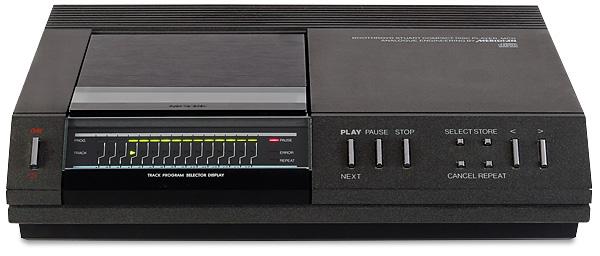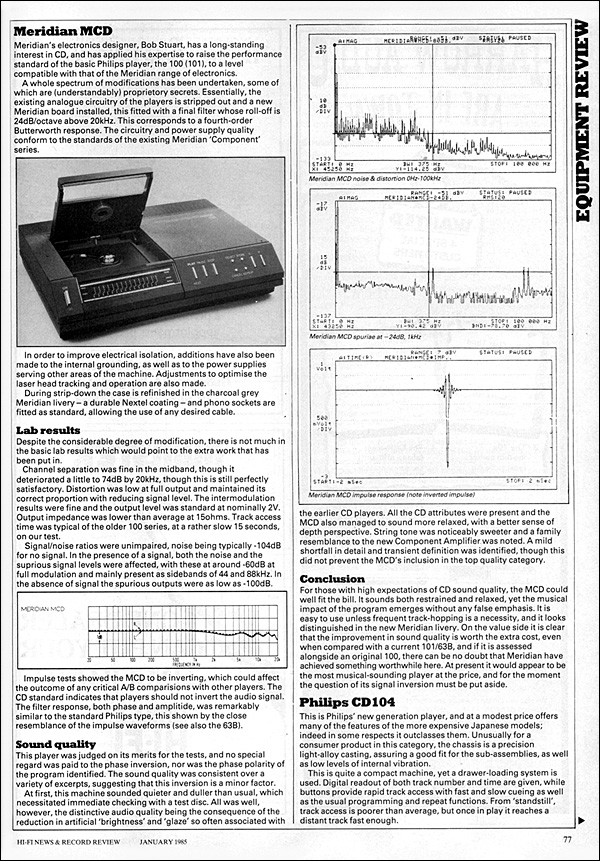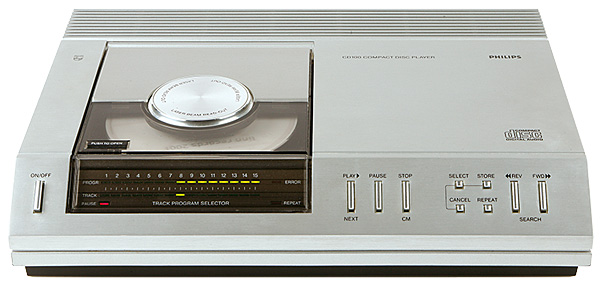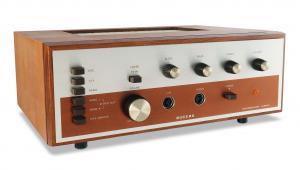Meridian MCD CD player

 It may have been based on a machine from Dutch giant Philips but this was the first CD player from a specialist high-end British manufacturer. How will it sound today?
It may have been based on a machine from Dutch giant Philips but this was the first CD player from a specialist high-end British manufacturer. How will it sound today?
Compact Disc enjoyed a halo of glamour in its early years that the more established formats had lost. Talk of laser beams and digital electronics, those holographic rainbows on the disc surface – not to mention all the smart new hardware – brought an interest in top quality listening to a whole new demographic.
But while '80s yuppies were snapping up as many Sony Compact 75s, Hitachi Opus 1s and B&O Beocenter 9000s as the stores could stock, there was a group of listeners unimpressed. The traditional audiophile, used to building up systems of eclectic components from specialist brands, eyed anything bearing a household name with suspicion. They were biding their time, waiting for something more esoteric and hopefully UK-made to appear.
Simply Does It
The problem was that the details of the inner workings of a CD player were unknown to all but the top engineers at Philips in Holland and the big Japanese multinationals. Equally, the ability to produce the necessary miniature laser optics and specialist ICs was outside the realm of all but the largest of organisations. As an example, a CD player's error-correction chip was reputed to be the most complex object that a private citizen could buy at the time.
Therefore, it was out of the question for a small firm to build a machine from scratch. Equally, there was little to be found in existing players that could be usefully modified and, in any case, much of the relevant circuitry was locked up in large scale integrated circuits. However, there were two areas of a CD player that were simple and accessible enough to try to improve – the power supply and the analogue filter stages, which follow the DAC. This was how the Meridian MCD came about.

Meridian at the time specialised in well designed equipment which, despite being audiophile focused, still fitted unobtrusively into the domestic environment. Compared to the company's neat preamplifiers and active loudspeakers, some of the early CD players looked like huge, gaudy hulks. But luckily there was one top-performing model that fitted the aesthetic bill perfectly.
The Philips CD101 (also sold as the Marantz CD-63B) was widely recognised as being one of the best sounding CD players on the market. It had just recently replaced the original CD100 [HFN Oct '11] – the first CD player available in Europe – and shared its basic form and layout. Internally, the first generation hand-assembled CDM0 transport module had been replaced by the CDM1, which was functionally equivalent but easier to produce (this is can be recognised by its die-cast housing). The PCB that processed the signal had also been re-drafted to improve the layout and make use – though limited – of newly available surface-mounted components.
Power Play
This helped to reduce assembly costs, a necessary move as CD player prices had fallen rapidly in the first few years of the format's life. For example, the CD101 cost two-thirds the price the CD100 sold for just two years previously.
Each MCD player started life as an ordinary, Dutch-made Philips CD101. The analogue filter components were then removed and an extra PCB containing the new Meridian circuit fitted in their place. At the same time, the capacitors whose job it was to filter the supply lines to the various chips were changed to different types and a few extra ones were added.

A change was also made to the power switch. The CD101 had a conventional switch that isolated the incoming mains supply when the player was not in use. In the Meridian version this was re-purposed to become a standby button, allowing all the mains wiring to be confined to one corner of the chassis. Finally, the cabinet top was stripped and resprayed with Meridian's trademark grey Nextel paint, matching the finish of the firm's innovative modular amplifier system. The resulting machine came with a price tag of £400, up from £295 for the stock Philips version.
The MCD appeared towards the end of 1984 and can be regarded as the first CD player having substantial engineering input from a British firm. Soon afterwards Mission introduced its DAD 7000, another synthesis of essentially the same concept but this time based on the drawer-loading Philips CD104 [HFN Apr '14].
Four By Two
Tweaking the filters of a Japanese machine such as the Hitachi DA-1000 [HFN Sep '16] – a popular OEM model – may well have had a greater effect when it came to the sound, but the audible superiority of the Philips arrangement was well known. The Philips players had the unique advantage of separate left and right channel DACs with 4x oversampling/digital filtering. The absence of oversampling in all the early Japanese designs obliged the use of sharp filtering at around 20kHz in order to reconstruct a smooth analogue representation of the encoded digital signal [see PM's Lab Report, p161].

New Order
Such filters unavoidably suffer from ringing around their corner frequency and generate phase distortion – two effects that noticeably colour the sound and adversely affect stereo imaging. Oversampling enabled Philips to design its filters with a characteristic that was much less abrupt, the standard players including a simple third-order Bessel filter that was essentially phase linear within the audio band. Meridian's re-interpretation of the circuit implemented a slightly steeper fourth-order characteristic at the cost of some additional complexity. The digital filter was, of course, unchanged.
The MCD has a similar sort of appeal as any early Philips player of its type. It is trim, pretty and feels solid and sturdy in a way that few CD players that have come along since have really equalled. It is also simple and logical to use, if one ignores the lack of a time display (no big deal) and a 'skip backwards' key (a real nuisance). However, direct top loading is preferable to waiting for a tray to grind its way open in an old player like this, and means no belts to stretch or gears to break. The CDM1 transport is its usual quiet, efficient self, apart from the odd chirping and slurping noises that they all seem to make when skipping (slowly) from one track to another.























































